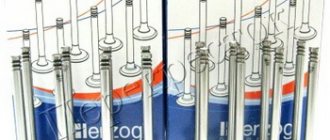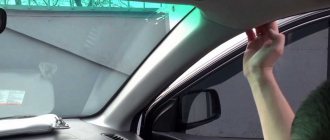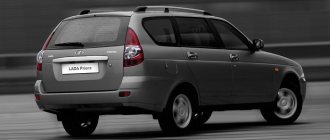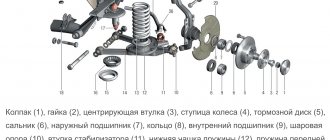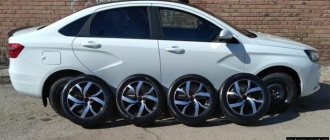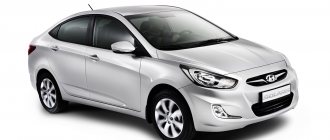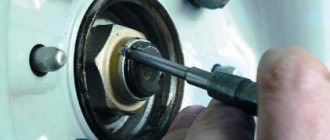The wheel hub bearings of a vehicle, like any component whose operation is based on the principle of close interaction of parts with each other, are subject to wear. Developers of modern domestic cars have adopted the technology of foreign colleagues, which is distinguished by the use of non-separable and non-adjustable bearings in the front hubs. However, the convenience of replacing such bearings presented in this case is relative, since it (replacement) is performed together with the hub.
This article is intended for owners of modern domestic cars who prefer to independently carry out the procedure for adjusting the wheel bearings, as well as such work as replacing the rear wheel hub bearing. Contrary to the fears of skeptics, such work does not require the use of specialized tools and complex devices.
Wheel Bearing Adjustment Tools
- A set of tools (hammer, bit, screwdriver, set of keys: “12”, “27” and torque).
- Jack.
- A set of new hub nuts (the mechanism for fixing the nut on the axle shaft does not ensure reliable fastening of the hub when reused).
see also
Comments 16
If play appears, this is not a signal to change the bearing. We have two cone roller bearings in the hub.
Fortunately, if there is play, then the bearing needs to be replaced. A lift is a temporary solution
It's true. But in a crisis, the solution is not bad)
In fact, I also improved myself last year. I have already bought new hub kits from Japanparts, the price tag on them is small, around two thousand it seems. I'll change it when it's warmer.
Fortunately, if there is play, then the bearing needs to be replaced. A lift is a temporary solution
I beg to differ, as in the field, the manufacturer recommends checking and tightening the thrust tapered wheel bearings based on mileage, this is a normal operation.
PS In fact, there should and always be a small gap, this is the so-called thermal gap. And if it’s not there, the bearing will roll on it sooner or later.
Read also: Production of plastic bumpers
Tightening and final adjustment occurs after approximately 600 km on the new bearing. Further, play may be a result of excessive wear, which should be resolved by replacement. I’m not arguing about gaps; naturally, a small amount of play should always be present.
Fortunately, if there is play, then the bearing needs to be replaced. A lift is a temporary solution
I pulled up 20 thousand))))
And then I went for a swim. And after a couple of weeks the bearing jammed
I forgot to write that after tightening, it would be nice to kick the wheel, and only then check) There the brake pads will loosen and the bearing will fit better.
Well, you got scared about re-tightening it)) - nothing will happen to it, if it’s not wrapped up like crazy, in a couple of thousand it will roll it and everything will be fine.
Yes, I forgot to write) I pulled it up a little bit at a time, after each approach I pumped and kicked the wheel.
I’ll correct it a little, the play is not vertical, the play is on the rolling, axial, the bearing must be tightened when the brake pads are loose, you must tighten it all the way, and then turn the wheel and loosen the nut until the moment when the wheel can freely spin by hand and make a revolution, and there is a special one for this key.
I forgot to write that after tightening, it would be nice to kick the wheel, and only then check) There the brake pads will loosen and the bearing will fit better.
Well, you got scared about re-tightening it)) - nothing will happen to it, if it’s not wrapped up like crazy, in a couple of thousand it will roll it and everything will be fine.
I usually spin along the movement, then suddenly stop and spin in the other direction. And so a couple of times. Then I check. Everyone has their own chips)
Read also: Ford Ecosport video review
ICE. Here's a question: when I bought a sports belt, the right wheel was loose (axial play), I changed the bearings, but the play remained... I assembled it as I took it apart, i.e. first the washer then the nut. What is the order of assembly? A couple of weeks ago I installed manual hubs and assembled them in the same way. The day before yesterday, while driving to the village, I heard a sound as if a wire had been wound and broken, the steering wheel was pulled to the left, as a result, the left bearing of the khan, the wheel was dangling. How should it be installed?
First the nut and then the washer!
Understood thanks! It turns out that I didn’t make it, the bearing was broken...
There's some pretty creative work with these bearings. The idea is that you screw on the nut, tighten it and turn the wheel a couple of turns. Until then, the bearings will fit as they should, and you can do 10 pull-ups. Then, when the bearings are in place, you turn the wheel back and forth and adjust the tension. Once everything is set up, you place the puck. It has holes around the perimeter. And lock the nut through these holes. So that it does not unwind and twist more than necessary. If you assemble without these washers (read washers and then nuts), then the right side will tighten arbitrarily while moving forward, and the left side, on the contrary, will unwind. Washers are needed to hold the nut in a certain position
Well, I realized that the washer is a stopper. I had nuts with cotter pins on my machines and, as I wrote, the washer was clamped with a nut, I thought that’s how it should be...
Wheel bearing adjustment process
a) The vehicle is installed on a relatively flat area and secured using the parking brake, anti-roll bars and other available means. b) Raise the rear axle of the car using a jack. c) Remove the axle shaft (pos. 8), and then check the free rotation of the wheel. If rotation is difficult, we eliminate its cause (sticking of the oil seal, touching the brake pads, etc.) d) Unscrew the lock nut (pos. 7) and remove the lock washer (pos. 6). Having unscrewed the bearing mounting nut (item 5) half a turn, we re-check the freedom of rotation of the wheel. We begin adjustment measures only after achieving easy and free rotation.
e) Using a torque wrench, tighten the nut (pos. 5) applying a force not exceeding 100 Nm, while turning the wheels. This will prevent uneven placement of the rollers in the bearings. f) Unscrew the nut (pos. 5) again. To maintain the required rotation angle (<450), we use the slots on the lock washer (item 6), that is, we turn it by 1-2 slots. We install the lock washer, while simultaneously controlling the entry of the lock pin into the slot. g) Tighten the locknut (item 7) with a force of 150-200 Nm. h) When checking the adjustment, check for free rotation of the wheel and the absence of axial play. i) Install the axle shaft (pos. 8) and spring washers, and then tighten the nuts securing the axle shaft studs. j) Lower the wheel until it touches the ground, and then make a test drive. If during driving the hub (pos. 10) gets very hot (70-750C), the adjustment process must be repeated.
Another fairly common question that arises among supporters of the domestic Automotive Industry is formulated as follows: “How to remove the rear wheel hub when replacing the bearing?” Let us pay due attention to answering this question.
The process of dismantling the hub is not particularly technically difficult, but the fragility of the bearings requires careful handling. Preparation for dismantling involves lifting the car and placing it on supports. The next stage of the preparatory process will be the removal of the wheels and brake drums (on cars with disc brakes - caliper and discs). We ensure the immobility of the vehicle by engaging the gear, parking brake and installing anti-recoil devices.
Next, we perform the following operations: a) Turn the flange and unscrew the bolts securing the hub to the bracket, using a special hole in the hub body for this (alternately align it with the bolts). b) Next, unscrew the bolts securing the caliper, brake pad guides and steering knuckle. c) We remove the hub through the brake mechanism and replace the worn bearing.
Causes of wheel bearing failure
When studying the problem, you need to know the reasons why the front or rear wheel bearing fails.
Note that the part has a hidden type of installation, and the main elements are covered with a casing to protect against the ingress of water and various types of contaminants.
Below we will analyze in detail what can cause technical breakdowns of the unit.
End of resource
With prolonged use, the hub bearings inevitably wear out. This is expressed in the expansion of the “tunnels” for the balls and the appearance of knocking.
As a rule, the problem manifests itself after 100,000 km and depends on the make/model of the car, the manufacturer of the part and driving habits.
In some domestic cars, the problem begins to manifest itself after 60,000 miles.
Careless operation of a car
If the driver does not take care of the car, often drives into holes/bumps at high speed, runs over bumps, etc., this leads to rapid wear of the suspension elements, damage to the hub and all its elements.
Poor sealing
Despite the closed housing, the grease inside may escape from the rear and front wheel bearings.
The reason may be the poor quality of casings made of rubber or plastic elements.
If the required amount of lubricant does not remain inside the part, it wears out much faster, begins to hum and does not perform its functions well.
Errors when tightening the hub nut
The machine's operating manual specifies exactly at what torque the hub nuts need to be tightened.
If you exceed the value set by the manufacturer, overheating is possible during movement, and this reduces the service life of the part.
Severely loose nuts can lead to slight play, which will also negatively affect the condition of the bearing.
The tightening torque is specified in the vehicle repair and operation manual.
Errors in pressing
This reason is rare, but it should not be ruled out. The problem may occur if the front / rear wheel bearing is installed incorrectly by a mechanic at a service station or by the owner himself.
As a result, the part becomes slanted (hardly noticeable), and its service life decreases.
Frequent crossing of water obstacles
It is normal for any wheel bearing to heat up while driving.
When passing water obstacles, the air inside is compressed, which literally draws moisture into the mechanism.
Water penetrates through the cracks of rubber seals, which lose quality over time. In this case, the crunch (hum) does not occur immediately, but after several days. This time is enough for rust to appear inside the part.
Frequent car overload
The manufacturer's recommendations indicate how much weight your vehicle can carry. Exceeding this parameter (even slightly) leads to an increase in the load on the front / rear wheel bearing.
As a result, the part wears out faster and fails.
Manufacturing defects
Many car owners save and buy parts from little-known brands from Russia and China. Such products often do not meet the warranty period and fail.
Defects can be expressed by a violation of overall dimensions, poor quality of seals, absence or a small amount of lubricant.
Damage to shock absorbers
When driving on the road, the main part of the load is taken on by shock absorbers, which soften the vehicle's ride in the vertical plane.
If they are faulty and do not cope with their task, the load on the hub bearings increases. As a result, the latter last less and fail faster.
To avoid such problems, it is necessary to monitor the condition of the suspension elements and promptly replace faulty parts.
This is especially important if you frequently drive on bumpy roads with heavy loads.
Overhang deviation for discs
If the offset is incorrect, the rear/front wheel bearings take on increased load.
As a result, their service life decreases, the part fails, and one of the most common signs of malfunction appears - a crunching sound.
Large wheel diameter
This reason is typical for all-wheel drive SUVs and commercial vehicles.
If the tire radius is larger than expected, the part experiences increased load during lateral acceleration. The area of greatest risk is the front wheel bearings.
Wheel alignment errors
When the wheels are installed at the wrong angle, the wheel bearings take on unexpected forces. As a result, one of the parties is constantly in overload mode, and this sooner or later leads to failure of the part.
Brake system failure
If the brakes malfunction, for example, friction of the pad on the disc, heating of the brake system elements and/or working fluid occurs.
In this case, heat is transferred to the part in question, which also overheats and wears out faster.
